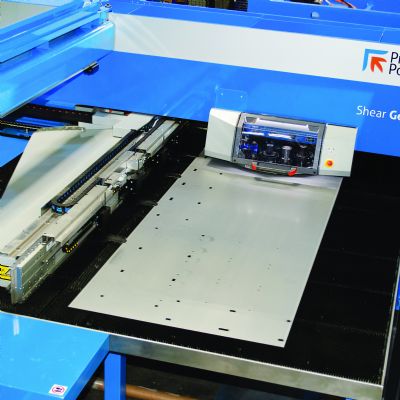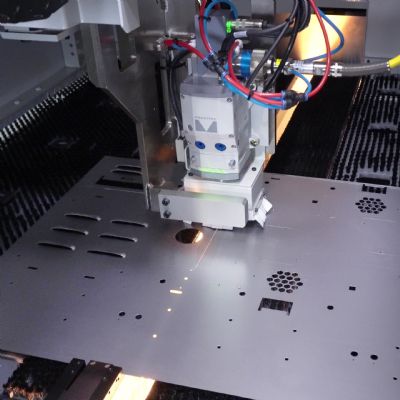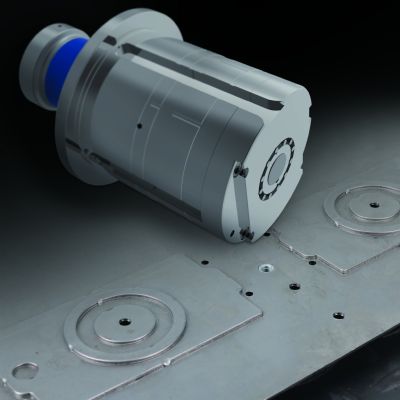 Brad Kuvin
Brad KuvinGreen-Light Time is Surging
June 1, 2016Comments
“Changing tooling in a turret press “is just a killer,” says Scott Berkowitz, president of metal fabricator EVS Metal, from the company’s 71,000-sq.-ft. headquarters facility in Riverdale, NJ. Berkowitz, who along with vice president Joseph Amico also operates plants in New Hampshire, Pennsylvania and Texas, recently has found a way to dodge the pain from press setups, which he says can last as long as 4 hr.
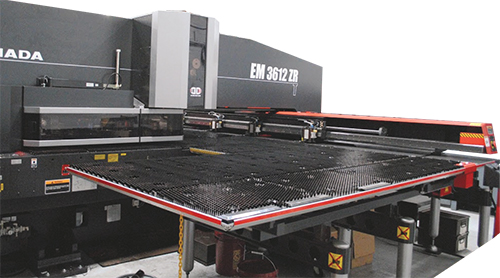 |
| An Amada EM 3612 ZRT machine—an AC servo-direct twin-drive press—has been a game changer for EVS Metal. It replaced three older presses, and boasts a green-light time greater than 90 percent. |
“The game changer for us,” he says, “has been a new AC servo-direct twin-drive press from Amada (an EM 3612 ZRT machine), equipped with a 300-station automatic tool changer. To squeeze every bit of productivity we can from the press, we filled it with new ID tooling, also from Amada. Those tools are etched with QR codes to allow us to gather production data from the shop floor and ideally manage our tool-maintenance program.”
The technology combination de-scribed by Berkowitz provides numerous benefits to EVS, making it nothing short of a complete game changer, he says. For starters, it allows not just for overnight lights-out production, aided by a six-shelf material-storage tower, but also for weekend lights-out production.
“Without the large-capacity tool changer,” says Berkowitz, “we’d typically only be able to run one job overnight, lights out, similar to how we run our other turret presses. But this machine, since it holds such a huge inventory of tools, lets us run as many as six different jobs unattended. Not only does that open up dozens of hours of extra machine time, but it’s changed how we can quote new work. Basically, run time like that comes at little relative cost, and tool changes become part of machine run time. That’s allowed us to, at times, reduce what we charge for run time, reduce our labor input and attract new customers.”
The Technology Behind EVS’s “Game Changer”
Sheetmetal fabricators strive for every opportunity to work more economically and effectively, and EVS is no different. One common end game to do so is optimizing green-light time on machines—as evidenced by Berkowitz’s plea to get out from under costly turret-setup times.
Here’s some overall industry perspective from Amada product manager Tim Brady:
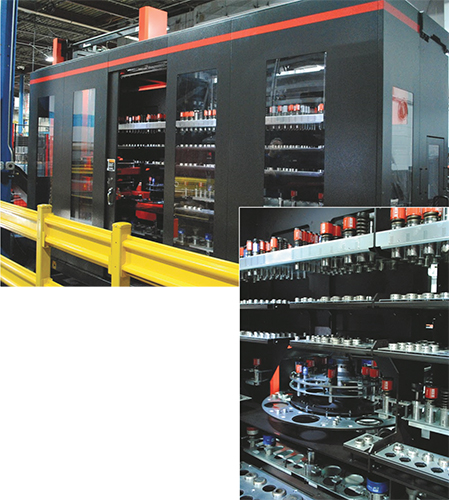 |
| The new turret press at EVS Metal is equipped with a 300-station automatic tool changer. To squeeze every bit of productivity from the press, EVS filled it with new ID tooling. The tools are etched with QR codes to allow the firm to gather production data from the shop floor and ideally manage its tool-maintenance program. |
“The typical stand-alone turret press can have a green-light time of only 30 to 40 percent in some cases,” Brady tells MetalForming. “Add sheet-handling automation and that might climb to 60 to 80 percent. As fabricators have consistently begun to add material-handling automation to their presses, they’ve now begun to think harder about their tool loads and changeover times. Add to that the trend to run smaller lots and more frequently move tools in and out of the turret, and the opportunity to dodge lengthy setups that restrict green-light time becomes increasingly enticing.”
Hence the development and adoption of automatic tool changers, equipped with Amada’s ID tooling—so-called “smart tooling.” Each piece of ID tooling features a unique QR code etched into its shank, which can be scanned in the tool changer and the turret. That practice allows for the collection of detailed tool-use data, and subsequent data analysis. Tool tracking via the QR code even can occur at an automated tool grinder—an Amada Togu III, in the case of EVS Metal.
“Once a tool moves into the tool changer or the turret, our software knows where it is and what it’s working on,” says Berkowitz. “Same goes for the tool grinder—it’s all part of a next-generation tool-management system that applies across the entire shop.
“Our tool database is accessible over the network,” he adds, “so programmers can see where all of the tools are at any given time, and can check on their condition based on hit counts. We can more-effectively manage tool maintenance, ensure optimum performance from every tool, and even keep track of how many times each tool has been sharpened. That sharpening data, from the Togu, then enables automatic die-height adjustment at the press—no need to manually shim the tools.”






